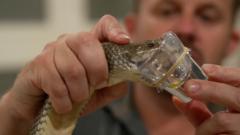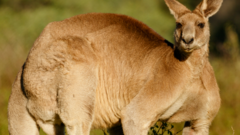In Australia, venomous spiders and snakes are crucial to developing antivenoms that save lives, with innovative programs relying on public participation to collect dangerous arachnids.**
Counterintuitive Heroes: How Deadly Australian Creatures Become Lifesavers**

Counterintuitive Heroes: How Deadly Australian Creatures Become Lifesavers**
Through a unique antivenom program, Australia’s venomous animals contribute to saving lives, showcasing the importance of conservation and public engagement.**
At the heart of Australia’s unique ecosystem lies a paradox: the very creatures that can threaten human life—like venomous snakes and deadly spiders—play vital roles in saving lives through antivenom production. Emma Teni, a dedicated spider keeper at the Australian Reptile Park, exemplifies this unique relationship. Using bright pink tweezers, she carefully extracts venom from the infamous Sydney funnel-web spider, a creature notorious for its lethal potential. In her small, cluttered office, Emma milks approximately 80 of these spiders daily, contributing to the country's ongoing antivenom program that has effectively eliminated fatalities since its inception in 1981.
While these spiders can deliver a deadly bite in mere minutes, the successful antivenom efforts have transformed a once-fearsome threat into a manageable risk. Emma emphasizes the importance of public participation in venom collection, as the program relies on community members safely capturing and delivering the dangerous creatures rather than resorting to extermination. Each spider collected and milked serves not only as a source of vital antivenom but also underscores the public's role in conservation.
Moreover, the Australian Reptile Park also focuses on snakes, collecting venom from various species, including King Brown snakes, essential for the development of antivenoms that have drastically reduced snakebite fatalities in Australia. The collected venom undergoes a lengthy process involving hyper-immune plasma extraction, where horses and rabbits are immunized to produce the necessary antibodies, culminating in life-saving treatment vials that are distributed throughout the country and even donated to Papua New Guinea, where snakebites pose a significant health risk.
The antivenom program not only mitigates risks from encounters with Australia’s most dangerous wildlife but also champions the conservation of these species. By fostering a sense of responsibility and engagement among the public, these initiatives redefine the relationship between humans and the dangerous animals they share their environment with—demonstrating that the true heroes might just be the creatures we fear the most.




















